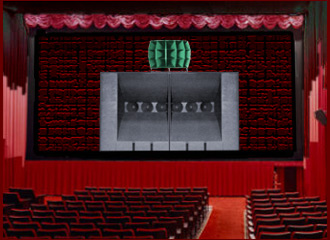
The Audio Section
Mr. Valve Hurling Thunder Into the Night!

Mr. Valve Hurling Thunder Into the Night!
![[Your Amp Goes To War]](images/hifi811.gif)
When I was but a young thing with dreams of DXCC in my fevered pubescent brain, I was taken to the last Los Angeles High-Fidelity Music Show. It was a religious experience.
At an age when I probably should have been reading sports magazines, I subscribed to Stereo Review and Audio.
Soon, I was finding out about such new forbidden teenage passions as:
McIntosh, which is spelled differently and has absolutely nothing to do with that Cupertino business concern that makes music players and computers on the side, is the stuff of legend. It's the kind of electronic company that all the engineers were starting right after WW II. In this case the founders were Frank McIntosh, and Gordon Gow. These guys realized that a major secret to good tube sound was good transformers, and it went from there. They designed ever more mysterious bifilar, pentafilar, and lord-knows-whatfilar transformers potted in square boxes and looking like small explosive devices. Today, their pro-level solid state gear still uses output autoformers. Yow!
McIntosh was among the drool-droolers of my technoid youth. They did their advertising by direct mail, straight to the freaks. We wireheads would sign up from their little ads in the backs of hi-fi mags, which always tempted us with a free FM station list. From that day forward, we'd be regaled quarterly (always in SCREAMING CAPS!) with the incredible numbers measured from some awesome box:
2000 W/CH AT 0.0005% THD!
WITH THE INCREDIBLE NEW MC990000X!Is your stereo system LIMITED BY A WUSSY POWER AMP? Are you losing those thrilling musical creschendos because of A LACK OF POWER IN YOUR AMPLIFIER? Is your love life being ruined by A POWER-HUNGRY LOUDSPEAKER? Do your engineer friends call you a WEENIE? Do you get an idea of the STYLE now?
The other cool sales thing was their Amplifier Clinic. They guaranteed specs of tube gear forever, or at least until it became too hard to get tubes they liked. You could lug in your MC275 for a bias tweak and scope checkup any time the techs came out to your local store. They also ran everyone else's stuff for THD versus frequency, secure in the knowledge that only a few other tube circuits had the cojones to hold up at either end. It was a further revelation to watch the class B solid-state circuitry of the era fall completely apart on low-power sine waves. No wonder the stuff 'sounded better cranked.'
McIntosh, fortunately, is still around, with the same factory in Binghamton, NY. The company is now owned by Clarion, a Japanese car stereo concern. While McIntosh has branched out into 1000-watt car setups of a sort liable to draw small-arms fire in noise-weary L.A., so far so good for the pro-audio line.
Just before I got into UCLA as an undergrad, I went to the campus open house. The graduate synthesizer room, at that time full of old-school Moog analog gear which is probably in someone's new-school vacuum tube home studio lo these many years later, was obviously all solid-state, except in the monitor rack, where lived two (2) MC275s.
I knew I'd picked the right college.
Marantz was the other drool-drool of my youth. It was started in the proverbial garage by 1950s tinkerer/engineer Saul Marantz. His stuff was built by and for audiophiles. The line was small, but every box in it still commands awe (and awesome prices) today.
If you really wanted to start a fist fight, you could always have brought up whether the empty-state Marantz 10B FM tuner was better than the high-end McIntosh superbox. My father knew a real genuine L.A. Marina Swinger, and he had a pad (hip L.A. talk) with a Marantz 10B and the tube amps you could reconfigure for Class A triode operation, and the preamp with all the knobs and the golden panel, and the big KLHs that stood on the floor.
Always seemed like kind of a waste of good equipment just to impress the latest female visitor. It impressed me, of course, but I was not exactly who he had in mind as the ideal guest on one of those brutal, 52-degree, L.A. nights. I never heard whether women approved of his equipment. It's one of those things kids really can't ask their elders.
By then of course Marantz had made the transition to solid state, but I doubt they'd ever really really recovered costs, and the company had been sold off to Superscope since 1964. It became like CBS and Fender. You just couldn't get the good stuff new, and old it was like buying from collectors, and cost like it. I kept hoping that a 10B would turn up at a garage sale:
"That old thing? It uses TUBES, for Chrissake. Tell you what, I like you, I'll get it out of your life for $100."
"I don't know... Joe thought the world and all of that radio. He told me to get at least $1000 for it....."
C'est le guerre.
Somewhere I still have a Marantz amp that was made in the Superscope era, and though it sounds OK, the general workmanship and engineering are not up to par. The circuit designs are nothing special, the unit was obviously assembled by some sort of Asian slave labor, it has a cheap feel, and the switches continually give problems.
Things picked up, somewhat, after Philips, the Dutch mega-conglomerate, bought the Marantz line worldwide, and (as of 1991) stateside as well. Now, I don't know if this ownership still exists, and the web pages, which have moved around a bit, are very little help, but there seems to be a renewed interest in the high end.
The current audiophile line looks interesting. It goes up to the inevitable $25,000 triode monoblock (yes, you need two for stereo). In an interesting marketing ploy to us firebottle types, they've re-issued some of the classic early 60s designs in what look like pretty decent copies, using NOS tubes where possible. I'll have to check this stuff out for assembly and craftsmanship, but it looks cool on the net.
Vintage Altec Lansing
These guys got their own page.
Serious gear for fearless people.The Big Speaker
Yet another teenage epiphany courtesy TannoyCharlie Lester's Ethéreal Esotérica
Charlie is a vacuum cleaner collector/ organist/ thereminist/ nice guy
who taught me the true meaning of the number 137. It was worth it.

go back to tonic key
flip your amp to standby and go for beer